
Solomon Islands is a sovereign state in the Melanesia subregion of Oceania in the western Pacific Ocean. This page is about the history of the nation state rather than the broader geographical area of the Solomon Islands archipelago, which covers both Solomon Islands and Bougainville Island, a province of Papua New Guinea. For the history of the archipelago not covered here refer to the former administration of the British Solomon Islands Protectorate, the North Solomon Islands and the History of Bougainville.

Guadalcanal is the principal island in Guadalcanal Province of Solomon Islands, located in the southwestern Pacific Ocean, northeast of Australia. It is the largest island in the Solomons by area and the second-largest by population. The island is mainly covered in dense tropical rainforest and has a mountainous hinterland.

Solomon Islands, also known simply as the Solomons, is a country consisting of 21 major islands Guadalcanal, Malaita, Makira, Santa Isabel, Choiseul, New Georgia, Kolombangara, Rennell, Vella Lavella, Vangunu, Nendo, Maramasike, Rendova, Shortland, San Jorge, Banie, Ranongga, Pavuvu, Nggela Pile and Nggela Sule, Tetepare, and over 900 smaller islands in Melanesia, part of Oceania, to the northeast of Australia. It is directly adjacent to Papua New Guinea to the west, Australia to the southwest, New Caledonia and Vanuatu to the southeast, Fiji, Wallis and Futuna, and Tuvalu to the east, and Nauru and the Federated States of Micronesia to the north. It has a total area of 28,896 square kilometres, and a population of 734,887 according to the official estimates for mid 2023. Its capital and largest city, Honiara, is located on the largest island, Guadalcanal. The country takes its name from the wider area of the Solomon Islands archipelago, which is a collection of Melanesian islands that also includes the Autonomous Region of Bougainville, but excludes the Santa Cruz Islands.
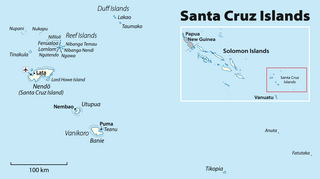
The Santa Cruz Islands form an archipelago in Temotu Province, Solomon Islands. They lie approximately 250 miles to the southeast of the Solomon Islands archipelago, just north of the archipelago of Vanuatu and are considered part of the Vanuatu rain forests ecoregion. The term Santa Cruz Islands is sometimes used to encompass all the islands of Temotu Province, Solomon Islands.
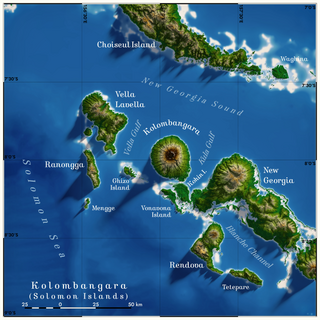
Kolombangara is an island in the New Georgia Islands group of the nation state of Solomon Islands in the southwestern Pacific Ocean. The name is from a local language, a rough translation of its meaning is "Water Lord" with approximately 80 rivers and streams running down its flanks.
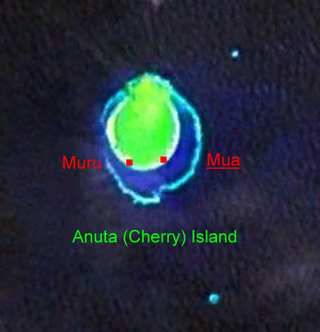
Anuta is a small volcanic island in the province of Temotu in the southeastern part of Solomon Islands. It is one of the smallest permanently inhabited Polynesian islands. It is one of the Polynesian Outlier communities in Melanesia.
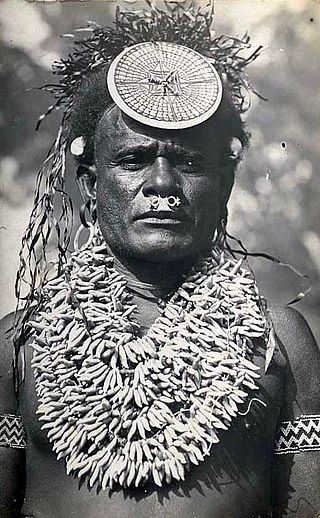
The culture of the Solomon Islands reflects the extent of the differentiation and diversity among the groups living within the Solomon Islands archipelago, which lies within Melanesia in the Pacific Ocean, with the peoples distinguished by island, language, topography, and geography. The cultural area includes the nation state of Solomon Islands and the Bougainville Island, which is a part of Papua New Guinea.

The Solomon Islands campaign was a major campaign of the Pacific War of World War II. The campaign began with Japanese landings and capture of several areas in the British Solomon Islands and Bougainville, in the Territory of New Guinea, during the first six months of 1942. The Japanese occupied these locations and began the construction of several naval and air bases with the goals of protecting the flank of the Japanese offensive in New Guinea, establishing a security barrier for the major Japanese base at Rabaul on New Britain, and providing bases for interdicting supply lines between the Allied powers of the United States and Australia and New Zealand.

Temotu is the easternmost province of Solomon Islands. The province was formerly known as Santa Cruz Islands Province. It consists, essentially, of two chains of islands which run parallel to each other from the northwest to the southeast. Its area is 895 square kilometres.
Kennedy Island, is a 1.17 hectares, uninhabited island in Solomon Islands that was named after John F. Kennedy, following an incident involving Kennedy during his World War II naval career. Kennedy Island lies 15 minutes by boat from Gizo, the provincial capital of the Western Province of Solomon Islands.

Sikaiana is a small atoll 212 kilometres NE of Malaita in Solomon Islands in the south Pacific Ocean. It is almost 14 kilometres in length and its lagoon, known as Te Moana, is totally enclosed by the coral reef. Its total land surface is only 2 square kilometres. There is no safe anchorage close to this atoll, which makes it often inaccessible to outsiders.
The angulate pipistrelle, also known as the New Guinea pipistrelle, is a species of vesper bat found in Papua New Guinea and the Solomon Islands.

The barred cuckooshrike, also called the yellow-eyed cuckooshrike, is a species of bird in the family Campephagidae. It is found in eastern Australia, Indonesia, Papua New Guinea, and Solomon Islands.
Rennell-Bellona, or Rennellese, is a Polynesian language spoken in the Rennell and Bellona Province of the Solomon Islands. A dictionary of the language has been published.

Solomon Islands–United States relations are bilateral relations between Solomon Islands and the United States. Initial relations were forged during World War II with what was then the British Solomon Islands Protectorate during the Japanese occupation, and this relationship remained strong as Solomon Islands gained its independence in 1978. Relations continued until 1993 when post-Cold War budget cuts closed the United States Embassy in Honiara. Beginning in 2022, in an attempt to counter growing Chinese influence in Solomon Islands, the United States has demonstrated increased commitment to the restoration of relations with the country. In February 2023, the United States re-opened its embassy in Honiara.
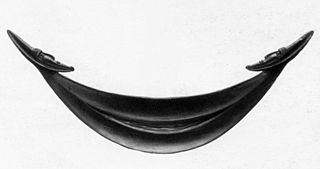
A reimiro is a crescent-shaped pectoral ornament once worn by the people of Easter Island. The name comes from the Rapanui rei and miro ('boat'). Thus the crescent represents a Polynesian canoe.
Matema Island or Matema is of one of the Reef Islands in Temotu Province, of the independent nation of Solomon Islands.

Honiara is the capital and largest city of Solomon Islands, situated on the northwestern coast of Guadalcanal. As of 2021, it had a population of 92,344 people. The city is served by Honiara International Airport and the seaport of Point Cruz, and lies along the Kukum Highway. In 1983, a Capital Territory – comprising the 22 square-kilometre metropolitan area of Honiara – was proclaimed, with a self-governing status akin to a province, although the city also retained an older role as capital of Guadalcanal Province.

Tomako or tomoko is a large war canoe from the Solomon Islands. The name "tomako" is used in New Georgia in the Roviana language. It is also known as magoru in Marovo, niabara in Vella Lavella, mon in Bougainville, ora in Makira, and iola or ola in Malaita and Ulawa. Tomako were narrow and usually between 12 and 18 m in length. They did not possess outriggers or sails and were propelled solely by paddling. They were built by fitting planks edge-to-edge which are then "sewn" together and caulked with a paste made from the nut of the tree Parinarium laurinum. They could carry 30 to 50 warriors, and were used in raiding expeditions for slaves or for headhunting. They were characteristically crescent-shaped, with sharply upturned prows and sterns that were decorated with fringes of cowrie shells, nautilus shells, and mother-of-pearl, as well as intricate carvings. These carvings are usually of spirit animals or warriors like the kesoko and Tiolo. The body is commonly blackened to contrast with the decorations.
Lisi is a type of plank boat from the Solomon Islands. It is crescent-shaped and is similar in appearance to the tomako war canoes, but differs in that the topmost strakes of the lisi have a gap in the middle. Lisi are also usually proportionally broader and less ornamented than the tomako. They are used for fishing and transport rather than for raiding. Lisi can vary in size from small canoes to large ships used for trade. The largest types of lisi are known as solima, which can carry 50 people and is used for long sea voyages. There are two general types of lisi, the ordinary trading lisi is known as the "lisi nume." An ornate lisi with inlaid shell decorations used for transporting village chiefs in diplomatic missions is known as the "la'o." Voyages of lisi to other islands usually required a ritual human sacrifice on the return trip known as siki po'upo'u.